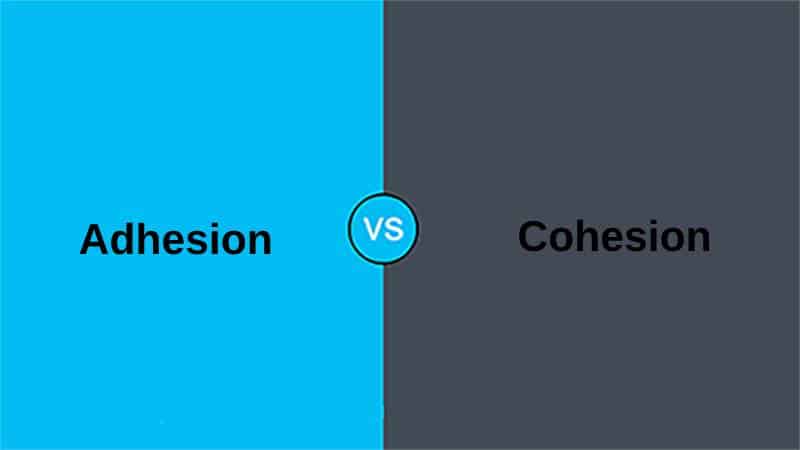When two or more molecules or different molecules come together, they form bonds by some forces. Adhesion and Cohesion are two phenomena that bind molecules with each other and help understand the nature of water. Both Adhesion and Cohesion sound similar, but they differ in some terms.
Adhesion vs Cohesion
The main difference between Adhesion and Cohesion is that Adhesion is a force of attraction that binds different molecules or substances, for example, water droplets on the surface of flowers and leaves. On the other hand, Cohesion is a force of attraction that binds two similar molecules or substances; for example, a water molecule forms a hydrogen bond.

Adhesion is an electrostatic force (force between two charged particles) or mechanical force (force between two objects when they come closer) occurring on two dissimilar substances or molecules. Adhesion is the force of attraction between two molecules. Water molecule on the plant’s leaves is the best example of adhesion.
Cohesion is a van der Waals force (a weak electric intermolecular force that binds molecules to one another in solidified, liquified, and gaseous states) occurring on two similar substances or molecules. Water molecules form intermolecular hydrogen with their molecules, which is the best example of cohesion.
Comparison Table Between Adhesion and Cohesion
| Parameter of Comparison | Adhesion | Cohesion |
| Definition | Adhesion is the force of attraction that sticks two, unlike molecules or substances. | Cohesion is the force of attraction that sticks two same molecules or substances. |
| Type of attraction | Adhesion is an intramolecular attraction force between two different molecules that binds one another | Cohesion is an intermolecular attraction force between two similar molecules that binds one another. |
| Nature of force | Adhesion is caused by the electrostatic force of attraction between two different kinds of molecule | Cohesion is caused by the Van der Waals and hydrogen bonding that attract two molecules of the same kind. |
| Effect | Capillary action and meniscus are the results of adhesive force. | Capillary action, surface tension, and meniscus are the result of cohesive force. |
| Example | The best example of adhesive force is water droplets are found on the surface of flowers, leaves, and plastic. | The best example of cohesive force is the formation of water droplets due to the surface tension of the liquid. |
What is Adhesion?
Adhesion is the force of attraction between two different substances or molecules. It binds molecules of two different natures. It detaches liquid droplets from the surface of the other substance. Unlike molecules or substances, it is a method of attraction interaction between the solid surface and liquid surface of two.
Adhesion is an intramolecular force (the force that binds atoms within the molecule or compound) of attraction that sticks two different molecules to one another. The adhesive force has a nature of mechanical force (binds two objects together) and electrostatic force (attracts two like or unlike charges particles towards each other).
The spherical shape of water droplets is the result of adhesive force. The adhesive property of the liquid surface depends upon surface wettability, the surface tension of the liquid, the volume of liquid droplets, and the procedure worked. The contact angle of the liquid surface to another surface also determines the nature of adhesive force. The surface has a larger contact angle with liquid droplets with lower adhesive force.
Capillary action (a liquid can flow in a tube against gravity) and meniscus (shape or curvature of liquid surface placed in the container) result from the adhesive force.
What is Cohesion?
Cohesion is the force of attraction between two like substances or molecules. It binds molecules of two similar natures. It is a mutual attraction between two similar molecules that stick together. It is found in both solid and liquid matter. Both particles of solid and liquid are bound by cohesive force.
Cohesion is intermolecular force (it is the force of attraction between atoms and other particles) of attraction that sticks two similar molecules to one another. The cohesive force has the nature of hydrogen bonding (electrostatic force of attraction between two hydrogen atoms) and the van der Waals force (the electric force that attracts molecules to one another).
Cohesive force is more frequent within water molecules where hydrogen bonding binds water molecules to each other. When rainfall happens, a raindrop falls into mist due to cohesive force. Raindrops’ water molecules come together and form the spherical shape of droplets.
Capillary action, the curvature of liquid in the container, and surface tension (the tendency of liquid to fix into the least surface areas possible) result from the cohesive force.
Main Differences Between Adhesion and Cohesion
- The adhesion is a force of attraction between two unlike substances and molecules. On the other hand, cohesion is a force of attraction between two similar molecules or substances
- Adhesion is the force that is caused by electrostatic force, whereas cohesive is the force that is caused by hydrogen bonding and van der Waals force.
- Adhesion and cohesion affect capillary action and meniscus, but cohesion also affects the surface tension.
- Adhesion is an intramolecular force of attraction between two unlike substances or molecules, while cohesion is an intermolecular force between two similar molecules.
- Adhesion is the reason for the spreading of water into the solid surface, whereas cohesion is the reason for the making of water droplets due to the surface tension of the liquid.
Conclusion
Adhesion and cohesion are attractive forces that bind similar and dissimilar molecules or substances. Both the force occurs simultaneously in the molecules, but the major difference between the two is that adhesion acts on similar molecules. On the other hand, cohesion acts on unlike molecules.
Adhesion is the reason for the spreading of liquid, and cohesion is the reason for the formation of liquid into droplets. Rainwater to droplet formation has the role of adhesion and cohesion.